If you’ve ever found a lizard in your home or perhaps trapped somewhere in your garden, you may have considered catching it so you can transport it to safety. However, they can be fast and skittish! This means capturing them with your bare hands isn’t quite as easy as it sounds. Thankfully, there are ways to catch wild lizards humanely! Want to know how to catch a lizard in the house? Read on.
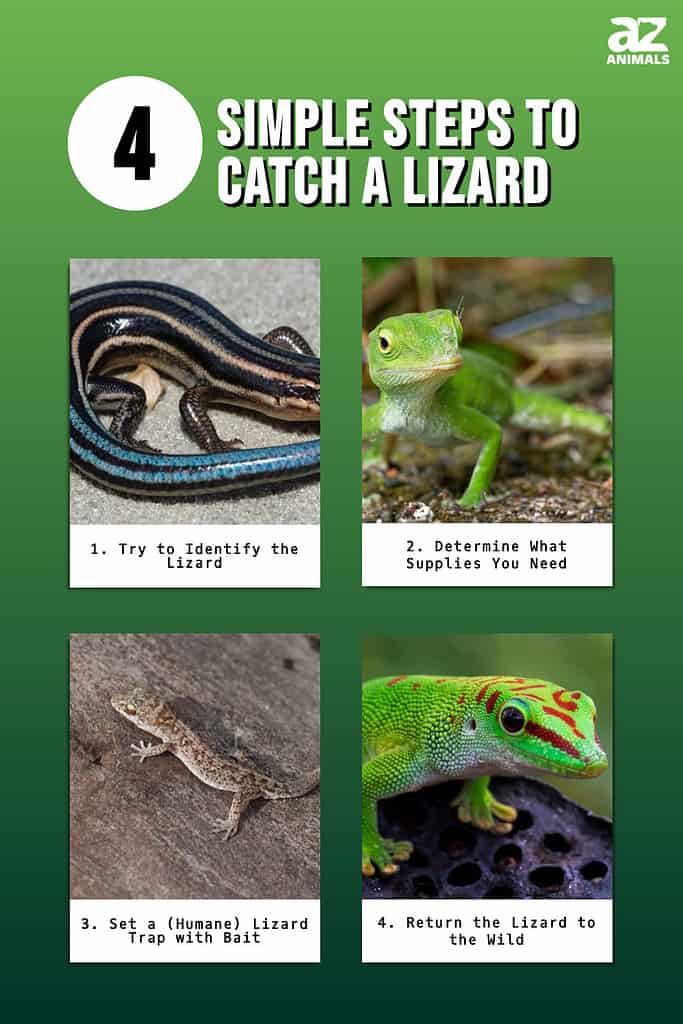
In this article, we’ll go over four simple steps to catch a lizard as quickly and painlessly as possible.
Step 1: Try to Identify the Lizard
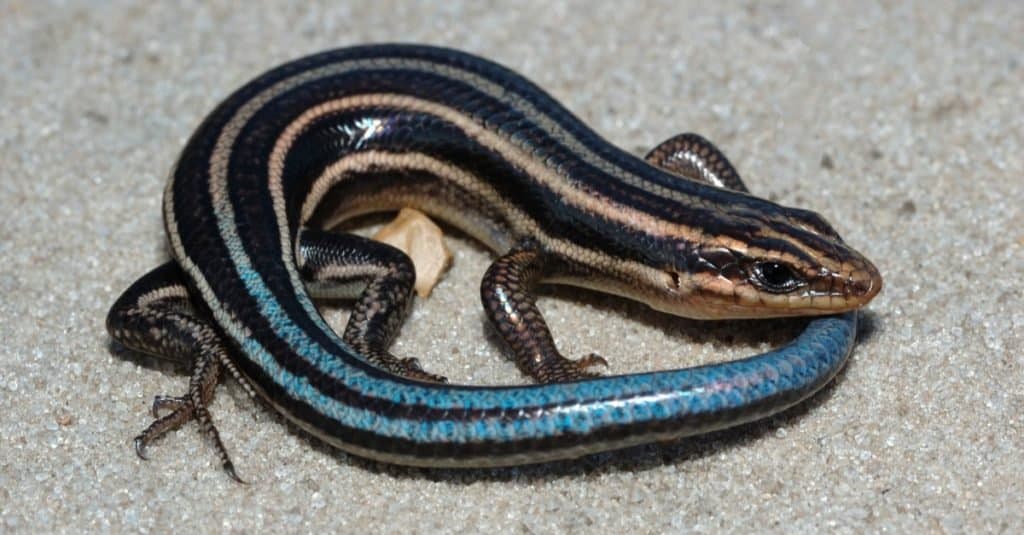
Five-lined skinks are commonly spotted in homes, gardens, and sheds throughout the United States.
©James DeBoer/Shutterstock.com
Before ever attempting to handle the lizard, you should first try to identify its species. If you can get close enough to the lizard, take pictures of it from multiple angles. Next, look into what types of lizards live in your area. Try to match one of them to the lizard in your home/garden/etc.
Knowing what kind of lizard you’re dealing with is important if you’re trying to capture it and guide it to safety. Take note of its size, coloration, and any other traits that stand out to you if you can get close enough to it. The lizard’s size and its preferred diet will also determine how you’ll be able to catch it.
Identifying the lizard will also let you know if it’s aggressive or more docile and handleable. Chances are, it won’t be venomous. There are only three truly venomous species of lizards: the Gila monster, the Mexican beaded lizard, and the Komodo dragon. Don’t try to capture these lizards (or very large species in general) on your own! It’s best to contact your local wildlife authorities if the species is venomous or particularly large and/or aggressive.
Additionally, if the lizard is a species that isn’t native to your area, you may have found someone’s escaped pet! If you can take pictures of the animal and can’t identify it yourself, consider reaching out to reptile hobbyist groups online with your photos to help.
Step 2: Determine What Supplies You Need

Anole lizards
are harmless and very easy to catch, but they can be very skittish.
©Martin Pelanek/Shutterstock.com
Depending on how large the lizard is and whether or not it’s docile enough to handle, the supplies you’ll need to capture it will vary. Very large lizards like iguanas can be dangerous when provoked. Smaller species are much easier to catch with humane bait traps. In some cases, you may be able to (gently) grab the lizard with your hands.
Some supplies you may need to catch a lizard in the house include:
- Thick leather gloves
- A container with air holes large enough to temporarily house the lizard
- Foods lizards enjoy like insects, vegetables, and fruits to use as bait
- A long-handled object like a broom to guide the lizard
- A box and plastic wrap and tape to build a humane trap
- A net with a handle (such as a small butterfly net)
If you were able to identify the lizard, you’ll now have a better idea of how to catch it. Its species will also inform you of its diet and whether or not it’s native (or invasive) to your area. If the lizard is invasive, very large, aggressive, or perhaps someone’s escaped pet, it may be best to contact local wildlife authorities for what to do next. If it’s native to your area and docile enough, you should be able to catch it and release it back into the wild.
On the other hand, if the lizard is somewhat large but docile, you may be able to simply guide it into a large box or container. If you’re going to try to pick up or touch the lizard yourself, be sure to wear thick leather gloves.
Most species aren’t particularly aggressive towards humans. However, some will still try to bite or whip their tails defensively if you approach them. When picking up a lizard, always approach it slowly from the side rather than above to avoid startling it. A net can also help you snatch up smaller, slower lizards.
For some lizards, you can use your long-handled broom to gently coax it into the box. Alternatively, you may be able to guide it outside without having to pick it up directly. Otherwise, make sure your transport box/container has air holes and a secure means of closing it. This will make sure the lizard doesn’t escape again.
If possible, have some food on hand that is part of the lizard’s natural diet. If it’s small and/or more skittish, as most lizards are, you’ll likely need to set a trap with bait to catch it more passively.
Step 3: Set a (Humane) Lizard Trap with Bait
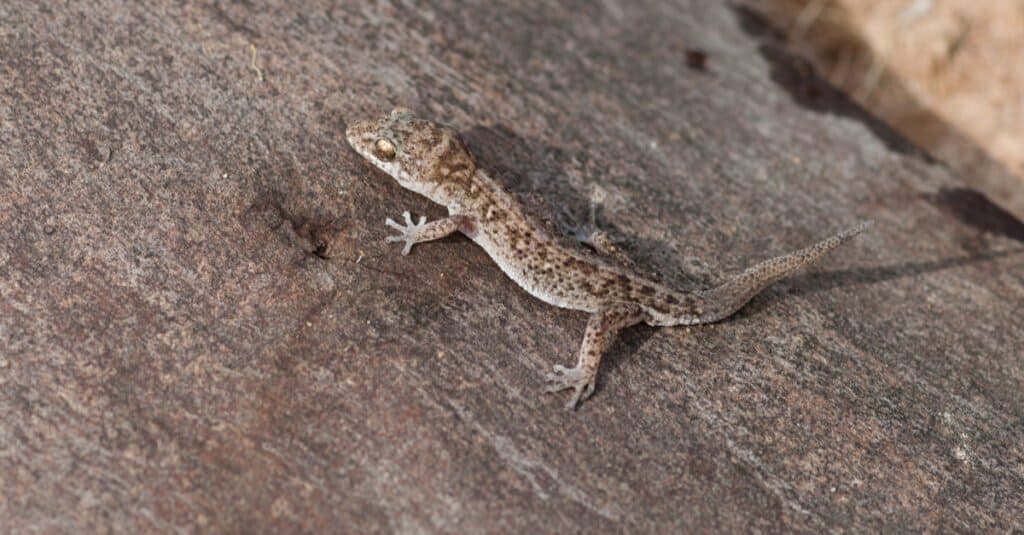
House geckos, as their name suggests, often take up residence in people’s homes in suburban areas.
©DOME PRATUMTONG/Shutterstock.com
If you weren’t able to catch the lizard on your own, it may be time to set up a trap. The best way to do this is to use a large box with an open top, some plastic wrap, and food/bait to attract the lizard.
To create a homemade lizard trap, first, secure a layer of plastic wrap over the top of the box. Next, cut a long slit in it. Place some of the lizard’s preferred food items on the plastic wrap near the slit. Put some food inside the box itself, too. It can also help to have a more secure lid for the box when you do manage to capture the lizard.
This way, the lizard will (hopefully) see the bait, take it, and fall into the box. Check the box often, as some lizards will still be able to escape with enough effort. Keeping a net on hand can also help if the animal somehow escapes the box or tries to run away. Keep those leather gloves on in case you need to handle it directly.
If you weren’t able to figure out what the lizard eats, place a few different types of food on top of the plastic wrap. Small insects like crickets and mealworms, vegetables like dark, leafy greens, and many sweet fruits like berries or bananas are all attractive to different types of lizards.
Next, you wait for the lizard to take the bait!
Step 4: Return the Lizard to the Wild
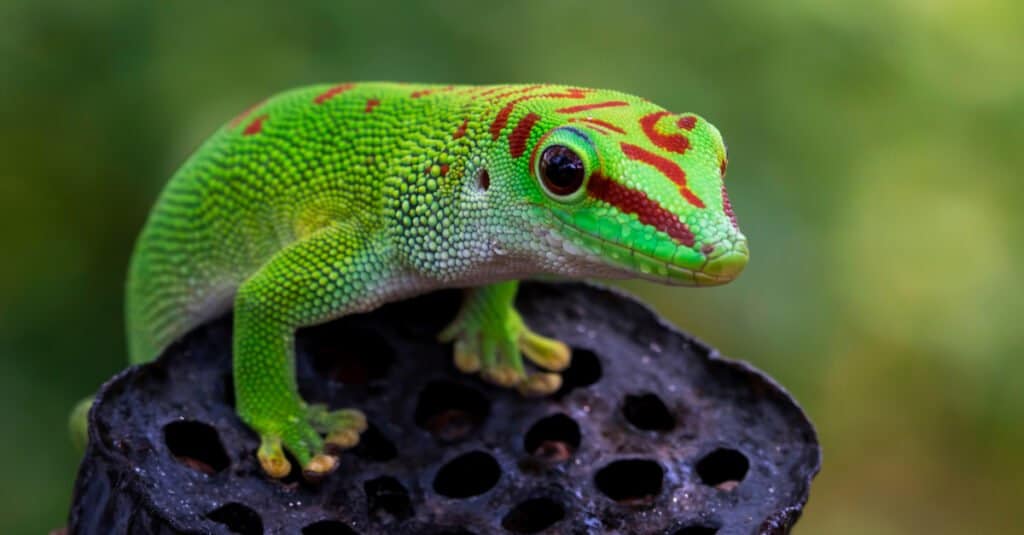
Some lizards, like day
geckos
, are very fragile and must be handled with extreme care.
©Kurit afshen/Shutterstock.com
If you had to set a trap to catch the lizard, be sure to check it every few hours if possible. Alternatively, set up a camera near the box if you’re able. Once the lizard has taken the bait and fallen into the box, you can quickly swoop in and either put a more secure lid on the box or transfer the lizard into a more secure container.
After you have the lizard contained, you’ll be able to release it into the wild or hand it over to local wildlife authorities.
If you weren’t able to definitively identify the lizard’s species before, you should be able to now. Take some more photos if you need to and determine if the lizard should be released into the wild or not. If the lizard is someone’s escaped pet, you may need to call local animal shelters.
Be very careful when transporting the lizard to avoid startling it. Some species will drop their tails when threatened. While this doesn’t necessarily harm the lizard, it does rob it of a valuable defense mechanism it could use to escape an actual predator.
When finding a spot to release the lizard, try to set it free somewhere safe with lots of dense plant coverage. Don’t take the animal too far away from where you found it, as this can disorient them.
Question: The lizard I just caught is so cute – can I keep it as a pet?
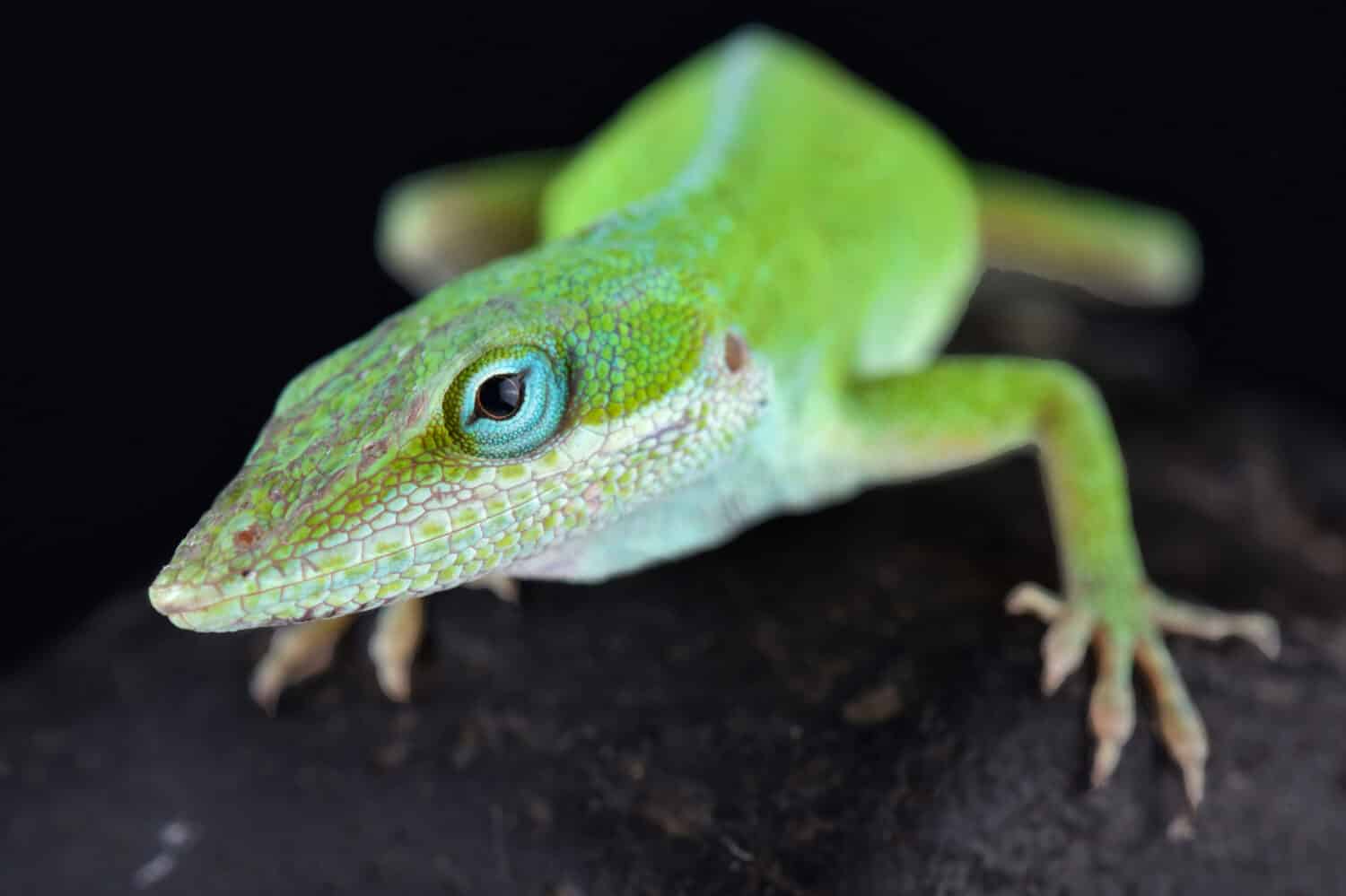
Green anoles are charming and make great pets – if they are purchased from pet stores.
Image: reptiles4all, Shutterstock
©reptiles4all/Shutterstock.com
You may be tempted to keep your adorable captured lizard as a pet – but please resist the urge! Lizards make great pets but keeping one that is used to living in the wild is a bad idea. The lizard will suffer from extreme stress in its new artificial environment and will be unhappy. Release the wild lizard and take a trip to the pet store! Reptiles bred in captivity are familiar with the sight and smell of humans and will be more comfortable in your home and with you. Lizards raised to be pets are also free of diseases that are picked up by their wild cousins. Exotic pets like lizards can encounter some hefty veterinary bills so it’s better to play it safe.
Summary of How to Catch a Lizard in 4 Easy Steps
| # | Steps |
|---|---|
| Step 1 | Try to Identify the Lizard |
| Step 2 | Determine What Supplies You Need |
| Step 3 | Set a (Humane) Lizard Trap with Bait |
| Step 4 | Return the Lizard to the Wild |
The photo featured at the top of this post is © Martin Pelanek/Shutterstock.com
Thank you for reading! Have some feedback for us? Contact the AZ Animals editorial team.






